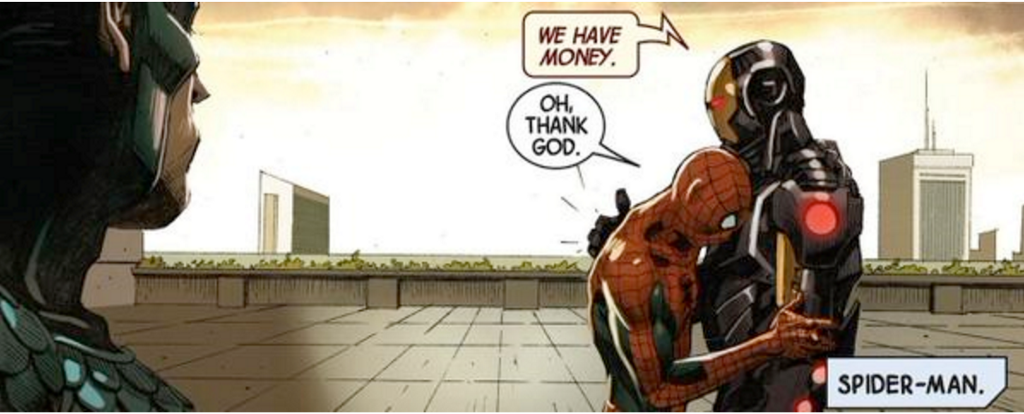With Great Finances Comes Great Responsibility
The financial world of superheroes

Comic books, especially superhero-led ones from major publishers, have always had the reputation of being mere escapism. But after World War II, comics have dealt with issues about race, gender, sexual orientation, geo-politics and philosophy, and of course, money and class. As Ramzi Fawaz, an English professor at the University of Wisconsin, explores in his book, The New Mutants: Superheroes and the Radical Imagination, these topics are often tackled head-on, if a little ham-handedly.
Lest I geek out endlessly, I’m limiting my discussion to the Marvel comics as their writers tend to talk about money more explicitly. Tony Stark (Iron Man), for instance, was intentionally created as capitalist figure that went against the usual left leaning politics of Marvel’s readers at the time. On the other end of the spectrum, you have Luke Cage who spent his early days as a hero-for-hire. Class issues are a major factor within initial run of the X-Men team/series, The New Mutants. While Roberto (Sunspot) comes from a rich family in Brazil, his teammates are not as fortunate: Sam (Cannonball) comes from a mining town in Kentucky, and Xi’an (Karma) is a Vietnamese immigrant who worked at the Xavier Institute in order to financially support her siblings.
Marvel heroes continue to deal with similar issues. Iron Man briefly had a stint as a San Francisco tech bro. Ms. Marvel (Kamala Kahn) is fighting supervillain funded gentrification in Jersey City. In Miami, Ant-Man (Scott Lang) runs a security company and is fighting villains taking advantage of the gig economy with the Hench app.
But Marvel has had a working (or lower-middle) class hero of sorts from the beginning: Spider-Man. Peter Parker’s major battle from the start, outside fighting a number of famous foes, has been trying to make ends meet.
From his inception, Peter is presented to the audience as something of an everyman, closer in age and economic status to the average reader than to other superheroes. He’s not a war hero, an alien or a mystical figure; he’s just a high school student from Forest Hills, Queens who accidentally gets bit by a radioactive spider. While other heroes were backed by scientific, military or educational institutions funded by family fortunes, Peter Parker had to get a day job.
Early issues had him balancing school, his job at the Daily Bugle and paying rent to his now-widowed Aunt May. He’s able to pay for the fictional Empire State University thanks to a scholarship. After marrying Mary Jane Watson, a model turned actress, the two manage to move into an apartment in Manhattan. It’s strange that villains gave the couple more problems than figuring out how to pay city rent on two creative class salaries.
While he’s most known for being a photographer (or selfie-innovator?) he’s also worked other jobs. It’s easy to forget that he went to school for science and has occasionally attempted to work as a scientist. He also briefly worked at his alma mater, the fictional Midtown High, as a part-time science teacher.
Despite his wide range of abilities and tools and the proportional strength of a spider, Spider-Man often fought street-level villains that are super-powered robbers like Vulture, Electro and Shocker, or guys in the mafia, like Kingpin. To further cement his everyman status, Spider-Man’s arch villain is the head of a corporation, Norman Osborn of Oscorp Industries a.k.a. the Green Goblin. Not satisfied with simple corporate greed, Norman injects a green strength and intelligence-boosting serum that drives him insane. He adopts the Goblin moniker as he attempts to take over the city’s organized crime.
But a lot has changed for the webhead recently: He’s hit big time in the comics. After years of going it alone, he’s been on-and-off Avengers teams and received Avengers-sized paychecks. For a time, he, MJ and Aunt May were able to live in Stark/Avengers Tower. The most interesting and recent development is that he now has his own company to run with one of his own villains to thank.
For a brief period of time, Doctor Octopus managed to “switch minds” with Peter. (The full explanation is more complicated, because comics!) Otto believed that he could be a superior version of Spider-Man and Peter Parker. He was partially correct, as he finally gets Peter his doctorate, upgrades his superhero tech and starts Parker Industries. But he turns Peter’s smart-alec personality into one that’s straight-up abrasive, which alienates friends, family and fellow heroes. Eventually, our Peter Parker gains control of his body back to save the day.

Now, Peter has taken Parker Industries global, his current status quo closer to Reed Richards or Tony Stark. (Those missing a friendly neighborhood Spider-Man shouldn’t fear: Brooklyn-born teenager Miles Morales is slinging through the city and stopping crime.) He hasn’t forgotten his uncle’s famous phrase, but his new challenge is interpreting it as the head of a worldwide tech company. He’s attempting to share innovative technology and his new-found money with people who need it the most, but that’s not without its own complications. While Peter might stay true to his values, will his company? There are start-up CEOs in the real world who are facing these same questions.
Alex J. Tunney lives in New York. His writing has been published in Lambda Literary, The Inquisitive Eater and The Ink and Code. He tweets @alexjtunney.
Support The Billfold
The Billfold continues to exist thanks to support from our readers. Help us continue to do our work by making a monthly pledge on Patreon or a one-time-only contribution through PayPal.
Comments